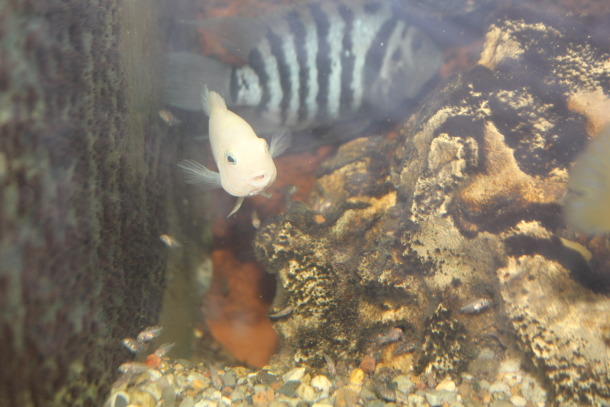In our newsletter No. 11 we ran the following contest:
“This month we are running another photo contest. I’m changing the contest from fish identification to something a bit more interesting (read, “more difficult”). The blurry photo below shows a mixed pair of Archocentrus nigrofasciatus, the convict cichlid. The striped fish in the background is the male. The pink fish in front of him is the female. The fry scattered around them consist of both normal striped fish and pink fish in roughly a 50:50 ratio. The winner will be the person who provides the best explanation for the roughly equal numbers of normal and pink fry in the brood. Email your answer to charles@goliadfarms.com. Please put “contest photo” in the tag line to make it easier for me to separate contest emails from others. The person providing the best answer will receive a free (including shipping) two pound bag of Simple Pet Products (www.simplepetproducts.com) #100 Grind fish food, which is perfect for most fish including all livebearers and small (1-2”) cichlids. I’ll be the sole judge of which answer is the best.”
The first correct answer came from Ron Bows. It’s a bit terse, but correct:
“The male is Heterozygous for the gene that produces a pink convict coloration. Because the male carries half the Pink genes a 50/50 ratio is born.”
Several others got the correct answer, but Ron beat them to the punch.
In convict cichlids pink is a semi-albino characteristic. Semi-albino because the fish produces no black coloration except in the eyes. It’s a recessive characteristic, meaning a fish must inherit the pink allele (an allele is a version of a gene) from both parents. The female in this case is pink because she has two pink alleles. This is termed homozygous, meaning the two alleles are the same. The male is heterozygous, meaning the two alleles differ and he has one for normal coloration and one for pink. He’s not pink because the allele for normal is dominant.
If the male had been homozygous for normal, then all of his offspring in this mating would have been normal colored because he could have only passed on normal alleles. But, since roughly half the offspring were pink and half normal, he must have had both alleles to pass on.
By the way, the pair successfully raised the spawn and many of their offspring of both colors are now independent from their parents and are large enough to not be eaten by their tank mates, which include about 80 large cichlids, mostly from Lake Malawi.


Tim says
how can I determine if my mollies are pure latipinna or hybrids?
charles says
Tim, Yet another good question.
The three sailfin molly species, Poecilia latipinna, P. petenensis, and P. velifera, hybridize among themselves very easily. Also, all three species readily hybridize with all the short fin molly species. Generally, commercial (domestic) mollies are hybrids, usually of one or more the sailfin species and short fin mollies of P. mexicana or P. sphenops. Short of performing DNA analysis on your fish, you could do morphometric analysis. This would consist of the counting scales and fin rays.
According to http://nas.er.usgs.gov/queries/FactSheet.aspx?speciesID=862, here are some distinguishing morphometrics for the three sailfin species:
Species Scales around caudal peduncle Lateral scales Dorsal fin rays
P. petenensis 20 28-29 12-16
P. latipinna 16 25-29 12-16
P. velifera 20 26-27 16-21
As you can see there is no clear cut set of counts to distinguish the species. Furthermore, hybrids can have the full range of counts. P. latipinna should have 16 scales around caudal peduncle, but its hybrids could easily have the same count. Another thing to consider is that each of these characteristics is subject to selection. By selecting P. latipinna with the largest number of fin rays, one could very quickly produce fish with higher fin ray counts.
Most wild populations of these fish are pure, but some such as the San Antonio River P. latipinna likely have some genes from other molly species due to release of aquarium fish.
In conclusion, the only way I know of being sure is to collect your own fish from isolated populations or get them from sources you trust.
Charles
Charles Clapsaddle says
I worry about you…